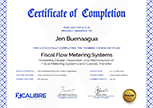| Date | Venue | Fee | |
|---|---|---|---|
| 08 Dec - 12 Dec 2025 | London - UK | $ 5,950 | Register Now |
| 16 Feb - 20 Feb 2026 | Dubai – UAE | $ 5,950 | Register Now |
| 29 Jun - 03 Jul 2026 | Dubai – UAE | $ 5,950 | Register Now |
| 14 Sep - 18 Sep 2026 | Doha - Qatar | $ 5,950 | Register Now |
| 12 Oct - 16 Oct 2026 | Dubai – UAE | $ 5,950 | Register Now |
About the Course
Grounding systems and hazardous area classifications safeguard personnel, equipment, and assets against electrical risks and hazards in high-risk environments. Effective grounding systems ensure that stray electrical currents are safely directed away from sensitive components, reducing the risk of shocks, fires, and equipment damage. In hazardous areas, proper classification is crucial to determining the correct type of electrical equipment needed to prevent ignition sources, which could otherwise lead to explosions or fires. Accurate hazardous area classifications are necessary to ensure that the correct safety measures are in place, such as explosion-proof or intrinsically safe equipment specifically designed for environments with explosive gases, vapors, or dust. Together, these components are essential for maintaining safety, regulatory compliance, and the smooth operation of electrical systems in industries such as oil & gas, chemical manufacturing, and mining.
This 5-day comprehensive Electrical Grounding Systems and Hazardous Area training course equips delegates with the essential knowledge and skills to implement and maintain electrical grounding systems while understanding hazardous area classifications. It emphasizes practical applications, allowing delegates to tackle grounding and area classification challenges, which cover safety protocols and compliance with industry standards, providing real-world scenarios for immediate field application. Delegates will be able to design, implement, and troubleshoot grounding systems, ensuring personnel and equipment safety. It is essential for professionals managing electrical systems in industrial environments to address complex safety challenges effectively.
Core Objectives
The delegates will achieve the following objectives:
- Identify the fundamental principles of grounding systems and hazardous area classifications
- Describe the key components, configurations, and safety requirements of electrical grounding and bonding systems
- Apply proper grounding techniques and classification methods
- Analyse potential risks associated with improper grounding and incorrect hazardous area classifications
- Evaluate grounding system performance and hazardous area classifications
- Design effective grounding solutions and classification strategies for hazardous locations based on site-specific requirements
- Develop troubleshooting and maintenance procedures to mitigate electrical hazards in high-risk industrial environments
Training Approach
This training course utilizes a combination of theoretical instruction and practical applications to ensure delegates gain both conceptual knowledge and hands-on experience. Interactive discussions, real-world problem-solving exercises, and group activities will reinforce key principles of electrical grounding and hazardous area classification. Practical demonstrations and guided assessments will help them apply industry best practices effectively in their work environments.
The Attendees
This training course is suitable for professionals responsible for ensuring electrical safety and regulatory compliance in industrial environments so that they will gain essential knowledge and skills to effectively implement grounding systems and manage hazardous area classifications in their respective industries.
It will be valuable to the professionals but not limited to the following:
- Electrical Engineers
- Maintenance Engineers
- Safety Officers
- Project Engineers
- Instrumentation Engineers
- Electrical Inspectors
- Facility Managers
- Operations Supervisors
- Plant Managers
- Industrial Electricians
- Utility Engineers
- Electrical Contractors
- Power Plant Engineers
- Oil & Gas Industry Professionals
Daily Discussion
DAY ONE: INTRODUCTION TO ELECTRICAL GROUNDING SYSTEMS
- Overview of Electrical Grounding Systems
- Types of Grounding Systems
- Grounding Electrode Systems
- Grounding Conductors and Connections
- Common Grounding System Configurations: TT, TN, IT Systems
- Industry Standards for Grounding Systems: NEC, IEC, IEEE
DAY TWO: ELECTRICAL GROUNDING IN PRACTICE
- Grounding System Design Considerations
- Measuring Grounding Resistance: Methods and Equipment
- Protection against Electrical Faults
- Impacts on Grounding System Design
- Testing and Maintenance of Grounding Systems
- Troubleshooting Common Grounding Issues
DAY THREE: UNDERSTANDING HAZARDOUS AREA CLASSIFICATIONS
- Introduction to Hazardous Areas: Definitions and Classifications
- Zones vs Divisions: Key Differences and Application
- Factors Affecting Hazardous Area Classification
- IEC and NEC Standards for Hazardous Area Classifications
- Understanding Zone 0, Zone 1, and Zone 2
- Material and Equipment Selection for Hazardous Areas
DAY FOUR: HAZARDOUS AREA CLASSIFICATION IN PRACTICE
- Hazardous Area Classification in Different Industries
- Risk Assessment in Hazardous Areas: Evaluating Potential Hazards
- Electrical Equipment and Wiring in Hazardous Areas
- Explosion-Proof and Intrinsic Safety Protection Techniques
- Compliance with Safety Regulations: NEC, ATEX, IECEx Standards
- Grounding and Bonding in Hazardous Locations
DAY FIVE: PRACTICAL INTEGRATION OF GROUNDING SYSTEMS IN HAZARDOUS AREAS
- Integrating Grounding in Hazardous Area Designs
- Explosion-Proof Grounding and Bonding Solutions
- Electrical Isolation in High-Risk Zones
- Risk Assessment and Mitigation for Grounding Systems
- Troubleshooting Grounding Systems in Explosive Environments
- Best Practices in Grounding Integration
Certificate Awarded
Upon successful completion of this training course, participants will be awarded a Certificate of Completion from XCalibre Training Centre, acknowledging their accomplishment. This certificate serves as a testament to their dedication to developing their skills and advancing their expertise in their respective fields.


